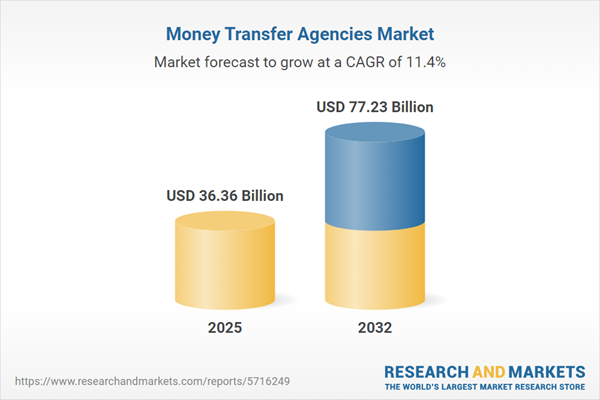Speak directly to the analyst to clarify any post sales queries you may have.
The global money transfer agencies market continues to transform as digital platforms, shifting customer behaviors, and regulatory changes redefine how capital moves across borders. Senior executives require actionable insights to outpace competitors and unlock growth within this dynamic environment.
Market Snapshot: Money Transfer Agencies Market Overview
The Money Transfer Agencies Market expanded from USD 32.60 billion in 2024 to USD 36.36 billion in 2025, and is set to maintain strong momentum with an annual growth rate of 11.38%, ultimately reaching USD 77.23 billion by 2032. This robust progression highlights sustained demand across retail, corporate, and digital-first channels as global remittances and cross-border payments become increasingly vital to trade and livelihoods.
Scope & Segmentation of the Global Money Transfer Agencies Market
This report provides a detailed evaluation of the market through a structured, multi-dimensional lens:
- Delivery Channels: Company owned agents, franchise agents, correspondent bank branches, retail bank branches, mobile apps on Android and iOS, and web portals via desktop or mobile browser.
- Transaction Types: Domestic (express, standard) and international (express, standard) transfer solutions, catering to diverse urgency and regulatory requirements.
- Payment Methods: Bank transfers (deferred and real time), cash options (pick-up, over the counter), e-wallets (domestic, international), and prepaid cards (disposable, reloadable).
- Customer Types: Corporates (large enterprise, small-medium enterprise) and individuals (expatriate worker, non-expatriate).
- Transfer Amounts: Ranges below 1,000, between 1,000 to 5,000, and above 5,000 units, aligning pricing and service options with specific customer segments.
- Regional Coverage: Americas (including North America and Latin America), Europe, Middle East and Africa (EMEA), and Asia-Pacific. The report details major and emerging economies within these geographies, reflecting intricate local market patterns and digital readiness.
- Key Companies Assessed: Market leaders and innovators, including The Western Union Company, MoneyGram International, Inc., Ria Financial Services, Xoom Corporation, Wise Plc, Remitly Global, Inc., WorldRemit Limited, OFX Group Limited, Skrill Limited, and Currencies Direct Group Limited.
Key Takeaways: Strategic Insights for Senior Leaders
- Digitalization is central to competitive advantage, with mobile applications, data analytics, and AI-driven solutions driving customer engagement and operational efficiencies across remittance journeys.
- Regulatory change, particularly around anti-money laundering and data privacy, pushes providers to heavily invest in compliance technologies and cultivate RegTech partnerships for real-time monitoring and risk reduction.
- Partnerships between legacy financial institutions, fintech startups, and e-wallet services broaden reach, accelerate innovation, and facilitate seamless cross-border experiences for both retail and corporate clients.
- Corporate and SME needs are evolving beyond basic remittance to include bundled services such as currency hedging, working capital management, and integrated treasury functions, promoting differentiation and deeper client relationships.
- Regional differences drive bespoke strategies: while the Americas emphasize digital innovation and loyalty programs amid mature regulatory oversight, EMEA and Asia-Pacific markets present opportunities in mobile-first solutions, local agent network optimization, and blockchain adoption.
Tariff Impact: Navigating New US Tariffs
- US tariff adjustments in 2025 have compelled providers to evaluate pricing frameworks, automate compliance, and renegotiate cross-border banking partnerships to manage cost exposures and maintain service excellence.
- Currency diversification and exploration of alternative transfer corridors have gained prominence, with operators seeking to minimize tariff vulnerability and leverage regional alliances or blockchain-based settlements.
- Advisory and bundled value-added services now help clients adapt to evolving tariff structures, strengthening loyalty and offsetting perceived cost increases.
Money Transfer Agencies Market: Methodology & Data Sources
Research is grounded in in-depth interviews with banking and fintech leaders, supplemented by industry publications, regulatory filings, and transaction data. Analytical frameworks blend econometric modeling and scenario analysis, cross-verified by sector experts and peer-review. Rigorous quality assurance ensures reliability, accuracy, and actionable insight for executive decision-making.
Why This Report Matters
- Equips leadership teams with a clear understanding of market drivers, emerging technologies, and region-specific strategies, providing the clarity required to outpace competitors.
- Delivers actionable guidance on navigating regulatory complexity, optimizing channel performance, and leveraging innovation to deepen customer engagement.
- Supports risk mitigation and investment prioritization by mapping value pools, competitive differentiation, and the impact of regulatory shifts.
Conclusion
Senior decision-makers will find this report indispensable for navigating the evolving global money transfer landscape. Its strategic analysis and actionable recommendations empower sustained growth, robust compliance, and proactive adaptation in a fast-changing industry.
Additional Product Information:
- Purchase of this report includes 1 year online access with quarterly updates.
- This report can be updated on request. Please contact our Customer Experience team using the Ask a Question widget on our website.
Table of Contents
3. Executive Summary
4. Market Overview
7. Cumulative Impact of Artificial Intelligence 2025
Companies Mentioned
The companies profiled in this Money Transfer Agencies market report include:- The Western Union Company
- MoneyGram International, Inc.
- Ria Financial Services, Inc.
- Xoom Corporation
- Wise Plc
- Remitly Global, Inc.
- WorldRemit Limited
- OFX Group Limited
- Skrill Limited
- Currencies Direct Group Limited
Table Information
| Report Attribute | Details |
|---|---|
| No. of Pages | 199 |
| Published | October 2025 |
| Forecast Period | 2025 - 2032 |
| Estimated Market Value ( USD | $ 36.36 Billion |
| Forecasted Market Value ( USD | $ 77.23 Billion |
| Compound Annual Growth Rate | 11.3% |
| Regions Covered | Global |
| No. of Companies Mentioned | 11 |









